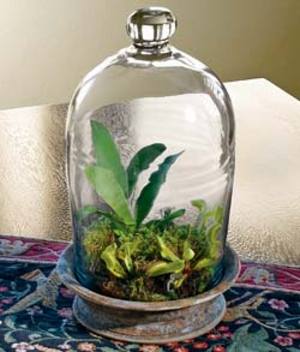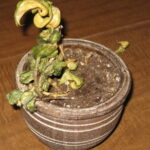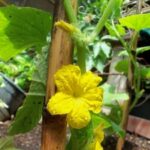One of the easiest ways to grow plants indoors is in a terrarium. A terrarium is simply a transparent container used for containing or growing plants inside. A terrarium is also used to house small reptiles, animals or insects on occasion also. The great benefit of growing plants in terrariums is the high humidity created under the glass, much the same as a miniature greenhouse. This is especially beneficial during the winter months with the dry heated air in our homes. The terrarium does the majority of the work for us, so it’s almost foolproof.
The plants chosen for the terrarium need to be compatible with similar light, water and humidity requirements. The terrarium needs to be kept out of direct sunlight so the plants will not over heat. The plants chosen for the terrarium need to be small and slow growing so they will not quickly become too large and outgrow it. Growing plants in a terrarium really is a simple and fun process. It’s also a good way to introduce children to growing houseplants. Terrariums are certainly not a new concept. They have been keeping plants happy for centuries.
There are many terrariums available for purchase, but any clear containers that are large enough to hold small plants will work. The glass will be used to form the dome or greenhouse portion of the terrarium, so it really doesn’t matter if the container is enclosed. The plants can be placed in a shallow bowl or other container and then covered with a bell jar, a clear lantern or just about anything available. You can also plant directly inside of a large jar, vase or similar container and then cover the opening with something clear to create the greenhouse effect. A fish bowl or an aquarium that is no longer in use for fish will make a wonderful terrarium.
Once the terrarium container has been chosen, there are a few other supplies to help the miniature garden to be successful. You will need small pebbles or aquarium gravel, activated charcoal (also called carbon and used in aquarium filters), sphagnum moss and a good quality potting mix. There are soil mixes available to purchase that are made especially for terrariums. These mixes just have extra drainage material added and can sometimes be difficult to find and aren’t really necessary. Start with a good light weight indoor potting mix made especially for container plants with plenty of peat moss in the mix. You can always add extra course builders sand, perlite or vermiculite for extra drainage. I save money wherever possible, but potting soils are not the place to do it. You will get what you pay for and probably dead plants if you use the cheap, heavy weight potting soils. They will only smother the plant’s roots and promote fungus and disease. Depending on the size of the terrarium, you can use household items for miniature gardening tools. Forks, spoons, chopsticks and small tongs can all help with the planting process, especially if the opening to the planter is small. Make sure all of the supplies are clean and sterile before using them by rinsing them in very hot water.
It’s time now to lay the foundation for the plants. Place a layer of small pebbles at least a half inch thick for good drainage and sprinkle the charcoal over the pebbles. The charcoal will absorb odors and keep the air from being stagnant in the terrarium. It is always a good idea to add a layer of sphagnum moss over the drainage layers to help keep the soil from washing down into the pebbles. Then add any necessary soil when you begin putting in the plants. It looks better to create little mounds and valleys with the soil to mimic a natural landscape as opposed to a completely flat soil surface.
Start with the smallest container plants you can find available, such as a 3 or 4-inch pot. The plants might still be too large to fit and may need to be divided and pruned before placing them in the terrarium. Try to choose a variety of leaf shapes and sizes to add interest. After placing the plants in the terrarium, finish with another layer of sphagnum moss to hold the soil in place. You can add little interesting twigs, rocks or shells to the miniature landscape if you want, just use your imagination.
Once the terrarium is planted and lightly watered, it will act like a little rainforest. The water evaporation will condense on the glass and rain back down on the miniature garden. If the plant’s leaves press against the glass for too long, they will rot from the moisture and create bacteria in the terrarium. These leaves can just be clipped off occasionally. A good time to do this is when the terrarium is uncovered for a few hours every week or two. This helps to promote good air circulation if the terrarium is completely covered and will help prevent mold. This time can be used to remove any yellow leaves or dead flowers. This is about the extent of maintenance for the terrarium. They can usually go for months without needing additional water.
There are several plant choices suitable for terrariums. The plants you choose will naturally depend on the size of container being used. If the choice is a large size aquarium, then obviously there is more room for plants than in a small goldfish bowl covered with a clear saucer. Small ferns make an excellent choice and love the humidity. The button fern (Pellaea rotundifolia) and the maidenhair fern (Adiantum cuneatum) are two good choices. The small heart-shaped trailing philodendron will also work well, as will any miniature ivy plants. Trailing plants will just need to be trimmed to keep them from outgrowing the terrarium too fast. A fantastic plant choice for a terrarium is the Fittonia spp. These small slow growing plants thrive on the extra humidity. They are commonly called “nerve” plants because of the intricate white or pink veining in the leaves. A beautifully delicate little plant known as Baby’s tears (Helxine soleirolii) is perfect for a terrarium. You can also use Irish moss (Selaginella spp.), Club moss (Lycopodium spp.), Miniature peperomia (Pilea depressa), Bridal Veil (Gibasis geniculata), and Prayer plant (Maranta leucoreura). These are just a few of the many choices available for terrariums. You can also use the popular carnivorous Venus fly trap (Dionaea muscipula) as long as you remember to leave a small opening for the food to fly inside the terrarium!
You can really experiment and try many different plants in the terrarium and if they quickly outgrow it, you can just remove them and add something new. It can be an enjoyable way to experiment with houseplants you may not be able to grow without the extra humidity. They also don’t require much space and can be a lovely table centerpiece. The moisture level inside the terrarium will still need to be monitored occasionally. If the sides of the glass are dripping with large drops of water and the terrarium is completely covered, then partially uncover it for a while. There should be some moisture on the sides and top of the terrarium so watch for signs of over dryness as well. If water does need to be added, it’s important to add a small amount at a time. When in doubt, less is best and will minimize the chances of rotting the miniature garden.
The soil in the terrarium should be adequate to feed the plants for a very long time, so fertilizing is rarely necessary. If the plants should become pale colored after a few months and you are certain they are receiving enough bright light, then a small amount of diluted liquid fertilizer can be added, but only a few drops at a time. This should keep the plants happy and healthy for another few years, but just remember you don’t want the plants to grow too quickly or they will all need to be replaced too soon.





